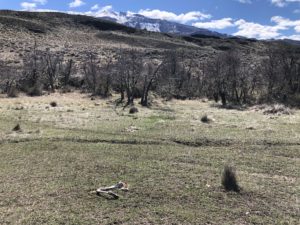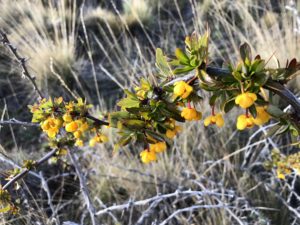by Christof Zweifel, of Carleton College
We spent the past week camping in Valle Chacabuco; surveying the guanaco population, critiquing neoliberalism, and learning about the steppe ecosystem. After eons as a home to the Aonikenk, then a few decades of ranching, and finally about fifteen years under the private conservation management of American millionaires Doug and Kristine Tompkins, Valle Chacabuco recently became Patagonia National Park; it is now administered by Corporacion Nacional Forestal (CONAF), which is analogous to the US Forest Service. We met with a couple of the CONAF rangers and are working with them on the guanaco population survey. Our campsite is located in the Eastern side of the valley at a trailhead built by the Tompkins Foundation.
For me, it was shocking to see the massive stone North-American-Park-style visitor center and campground shelters just down the road from our campsite outside the town of Cochrane. The buildings here do not quite match with the smaller wooden or adobe style of Cochrane and surrounding ranch houses.

Our first day of surveying had to be my favorite! We woke up early to have oatmeal and drive ~1.5 hour to the first set of walking transects. In this research protocol, a walking transect is walking on a compass bearing and taking data about all guanaco we see. My group was dropped off 10kms from the park entrance and began walking north. We took out our binoculars and immediately started spotting guanaco. Initially, our sightings were chaotic with three people each trying to count guanaco, find the direction + distance, and record GPS data, but after a while we were able to get the system down. I was in charge of the GPS and immediately after the first sighting led my group to a stream that had swollen with water from last night’s snow. The last thing I expected when I signed up for this semester was to strip down to my underwear in the Patagonian steppe and wade through freezing cold water up to my thighs. The only thing more unexpected was when we reached the top of the ridge in front of us and realized the stream took an abrupt turn to the northeast and passed through our transect a second time…
Being at the top of the ridge scanning the steppe below for guanaco was a surreal experience. Every time we thought we had seen all of the guanaco below, one of use would chime in, “Did we count that one yet?”, and we would stop to take down the sighting. On the plain below the ridge we made good time, passing by guanaco within 20-50 meters. Behind us on the ridge, condors would swoop over our heads. The first time we saw a condor it passed over our head so close I could hear the swoosh as the shadow flickered past. In total we saw seven condors circling over the ridge and almost 100 guanacos on our way north.
Coming back south we were able to follow guanaco tracks across the stream at shallower crossings. The guanaco tracks from all directions converged at one point near the river where the grass was tramped down. As we passed, we noticed scattered bones and fur. It looks like the puma or foxes wait near this crossing and ambush guanaco; not the best thing to realize when you’re standing there in your underwear.

The next few days had far less guanacos for me, but just as many river crossings. The north side of the valley is crisscrossed with braided channels of a glacial river and dotted with Mallin wetlands that are home to flamingos, swans, and coots. I spent much of the day learning to identify common steppe plants and birds. Many of the plants here form cushions to prevent water loss and are full of thorns. Lots give of aromatic smells like honey or perfume. I can even ID some by smell alone! During the survey another team managed to get a glimpse of a puma walking in the steppe. Yet another saw some ñandú (Darwin’s Rhea) grazing with a herd of guanaco on their transect. Ñandú are an endangered flightless bird similar to an ostrich.

In the evening we have class and cook over our camp stove. We have discussed a lot about the creation of Patagonia National Park and the history of humans in the environment. What I have learned has put my thoughts on conservation and protected areas into perspective and given cause for reflection. I am especially interested in how human habitation has influenced biodiversity for millennia and how these two concepts can coexist in conservation. After class, our dinners have been fantastic. I think our pot must be magic because whatever we have thrown in has turned out delicious. I never knew camp cooking would be this good. Huge shout out to my team for the food and being dedicated cooks.
At night we get to relax and play cards. The wind often picks up, but we have a tarp and a camp shelter in which we read and hang out at night. On our last night here, we had a dance party under the stars. I am sad to leave Valle Chacabuco but excited for our next adventures and homestays!
